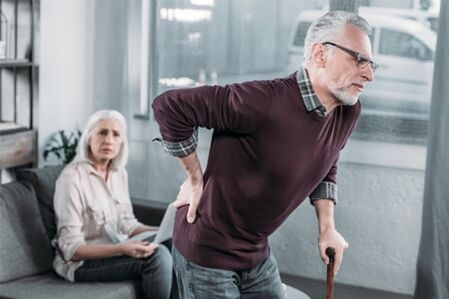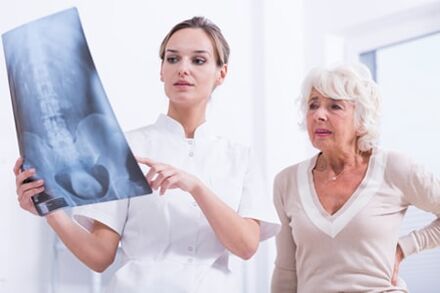
Degenerative-destructive lesion of the spinal column, otherwise:osteochondrosis- a disease that includes damage to a person's ligament and joint apparatus, intervertebral discs and vertebral bodies.
Osteochondrosis disease mainly affects older people, regardless of gender, although it should be noted that recently there has been a tendency to rejuvenate this disease. Such rejuvenation of osteochondrosis is directly related to poor physical development in children and overweight in so many adolescents. In addition, modern young people prefer sedentary pastime near the TV or computer, avoiding sports. The combination of these factors leads to weakening of the back muscles, posture disturbances and other negative consequences for the spine.
Osteochondrosis and its causes

At the heart of the disease with osteochondrosis is a disorder of the trophism of the vertebrae and intervertebral discs, which changes the normal structure of tissues. As a result, the cartilage disc loses its normal elasticity and shape, reducing the width of the spaces between the vertebrae. Violation of the intervertebral relationship leads to compression of the nerve endings of the spinal cord, as well as a significant overload of the spinal muscles, which explains the manifestation of pain in osteochondrosis. In addition, with osteochondrosis, quite serious complications also often occur, such as swelling of a part of the intervertebral disc and vertebral hernia.
In the future, the degenerative-destructive changes that occur in osteochondrosis lead to the formation of bone growths in the vertebrae, also spreading to the intervertebral ligaments and small joints of the spine. It becomes difficult for people suffering from osteochondrosis to perform flexion-extensor movements and over time they can develop pathologies - scoliosis or kyphosis.
All of these degenerative-destructive spinal injuries are usually the result of the inevitable physiological aging of the human body, but for a number of reasons discussed later in this publication, the osteochondrosis process can accelerate significantly.
It should be noted right away that there is no single cause for the onset of osteochondrosis, but there is a large number of predisposing factors, and the main ones are:
- bruises, fractures, dislocations and other injuries of the spine;
- hereditary predisposition;
- various foot diseases that cause vertebral overload, such as clubfoot, flat feet and others, as well as prolonged wearing of uncomfortable and tight shoes;
- obesity or excessively overweight;
- natural age-related changes in the body;
- violation of metabolic processes in the body;
- maintaining a sedentary lifestyle;
- abrupt cessation of professional sports;
- the specifics of professional activity, for example, frequent jerks and turns of the body, weight lifting, uncomfortable position of the body during work;
- prolonged and frequent hypothermia, aggravated by high humidity;
- the presence of frequent and prolonged stressful conditions.
The presence of several or even one of the above factors can lead to the development of osteochondrosis, which is conventionally divided into four stages:
- First stage- a decrease in the amount of moisture contained in the intervertebral disc with a decrease in the intervertebral distance. In this case, small cracks appear in the cartilage.
- Second phase- due to the decrease in the intervertebral spaces, a collapse of the ligament and muscular apparatus occurs, which entails an unnatural mobility of the vertebral bodies, their displacement and slippage.
- Third stage- due to the progressive degenerative-destructive lesion of the vertebral column, there is an extrusion of the intervertebral discs, as well as vertebral subluxations.
- Fourth stage- in order to prevent subluxations and unnatural vertebral mobility, bone osteophytes grow between the vertebrae, in folk treatment they are called "saline deposits", which over time become so numerous that the vertebrae lose mobility. With such bone growths, injuries of the nerves and vessels located near these vertebrae inevitably occur.
It should be noted that in the first and fourth stages of osteoarthritis, patients feel no pain.
Osteochondrosis and its classification
Although osteochondrosis has many different classifications, the most common is the classification of osteochondrosis, which takes into account the localization of spinal injuries:
- osteochondrosis of the cervical spine;
- osteochondrosis of the thoracic spine;
- osteochondrosis of the lumbar spine;
- osteochondrosis of the sacral spine;
- common osteochondrosis, which includes a disease of two or more vertebral sections.
Osteochondrosis and its symptoms
Osteochondrosis, as a disease, is chronic in nature and is characterized by the alternation of the phase of remission and the phase of exacerbation, in which the symptoms of osteochondrosis are particularly characteristic, depending on the location of the spinal disorder, as well as the presence of possible complications.
So, for osteochondrosis of the cervical region, pains directly in the neck, hands, some stiffness of movements, headache and numbness of the fingers will be characteristic. Well, in case of compression of the vertebral artery, the patient has a headache of a throbbing nature, a decrease in the functions of the hearing aid, dizziness and fainting is also possible.
The symptoms of osteochondrosis of the thoracic region are somewhat different. The patient is concerned about aching pain in the back, which can also be of an acute nature, difficulty in breathing with full breasts, pain in the heart, as well as a sensation, so-called in folk treatment - "runny in the chest".
Symptoms of osteochondrosis in case of damage to the lumbar spine are manifested by pain in the lower back, legs, sacrum and intensify during movement. In addition, numbness of the legs appears, and various dysfunctions of the genitourinary organs can develop.
During the phase of remission, a sick person may also experience pain that is not pronounced and which occurs only in case of provoking factors, for example, an uncomfortable position of the patient's body.
Osteochondrosis and its diagnosis

First of all, patients should take into account that a neuropathologist is engaged in the treatment of osteochondrosis. Diagnosis of osteochondrosis, as a rule, includes the following steps:
- question the patient;
- external examination and palpation of the patient's spine in different positions of the body, as well as the establishment of a possible range of motion;
- special studies for the diagnosis of osteochondrosis through magnetic nuclear resonance, computed tomography and radiographic examination of the patient;
- special studies of peripheral nerves and blood vessels, but only in cases necessary for the correct diagnosis of osteochondrosis.
If you do not engage in the timely and correct treatment of osteochondrosis, preferably without resorting to folk remedies, then there is a real danger of developing various complications in the form of diseases such as, for example, sciatica, herniated disc, migraine, vegetovascular dystonia and with lumbar osteochondrosis - also spinal stroke. Therefore, it is necessary to pay due attention to the diagnosis of osteochondrosis and its treatment, avoiding independent alternative treatment methods, so as not to start the development of this disease.
Conservative treatment of osteochondrosis
In the treatment of osteochondrosis in medical institutions, in contrast to traditional medicine, classical methods of its treatment are used. At the same time, the attending physician uses a strictly individual approach to the patient. Treatment of osteochondrosis to achieve effectiveness is carried out in a complex way. The same conservative methods of treatment of osteochondrosis are divided into the following groups:
- Treatment of osteochondrosis with drugs.
- Physiotherapeutic treatment of osteochondrosis, in particular magnetotherapy, through the use of special medical devices.
- Sanatorium treatment of osteochondrosis.
- Organization of proper nutrition, with the help of a special diet.
Surgical intervention in the treatment of osteochondrosis
Treatment of osteochondrosis with the help of surgery is carried out only in cases where the above conservative methods do not give the desired effect. The most common is the removal of an intervertebral hernia, in which the surgical incision does not exceed one centimeter and the patient can stand up the next day. Well, the course of complete patient rehabilitation is completed within six months of surgery.
There is also a method of treating osteochondrosis through surgery, in which the affected intervertebral disc is removed and a silicone prosthesis or prosthesis is installed in its place, which leads to the restoration of the necessary distance between the vertebrae and, accordingly , the elimination of symptoms of osteochondrosis.
Prevention of osteochondrosis diseases
First of all, for the prevention of osteochondrosis, you should:
- avoid increased stress on the spine by wearing comfortable shoes;
- try not to stay in an uncomfortable position of the body for a long time;
- exercise regular control of your weight, avoiding the yoke of excess;
- always maintain correct posture;
- when lifting weights, use both hands evenly;
- carry out general strengthening exercises daily, as well as pay attention to regular yoga or pool classes;
- follow a diet that includes foods such as fish, leafy greens and vegetables, dairy products, jellies and jellies, broths, eggs, butter and olive oil in your diet;
- avoid alcohol, fizzy drinks, overly strong coffee, salty foods, and fatty meats.























